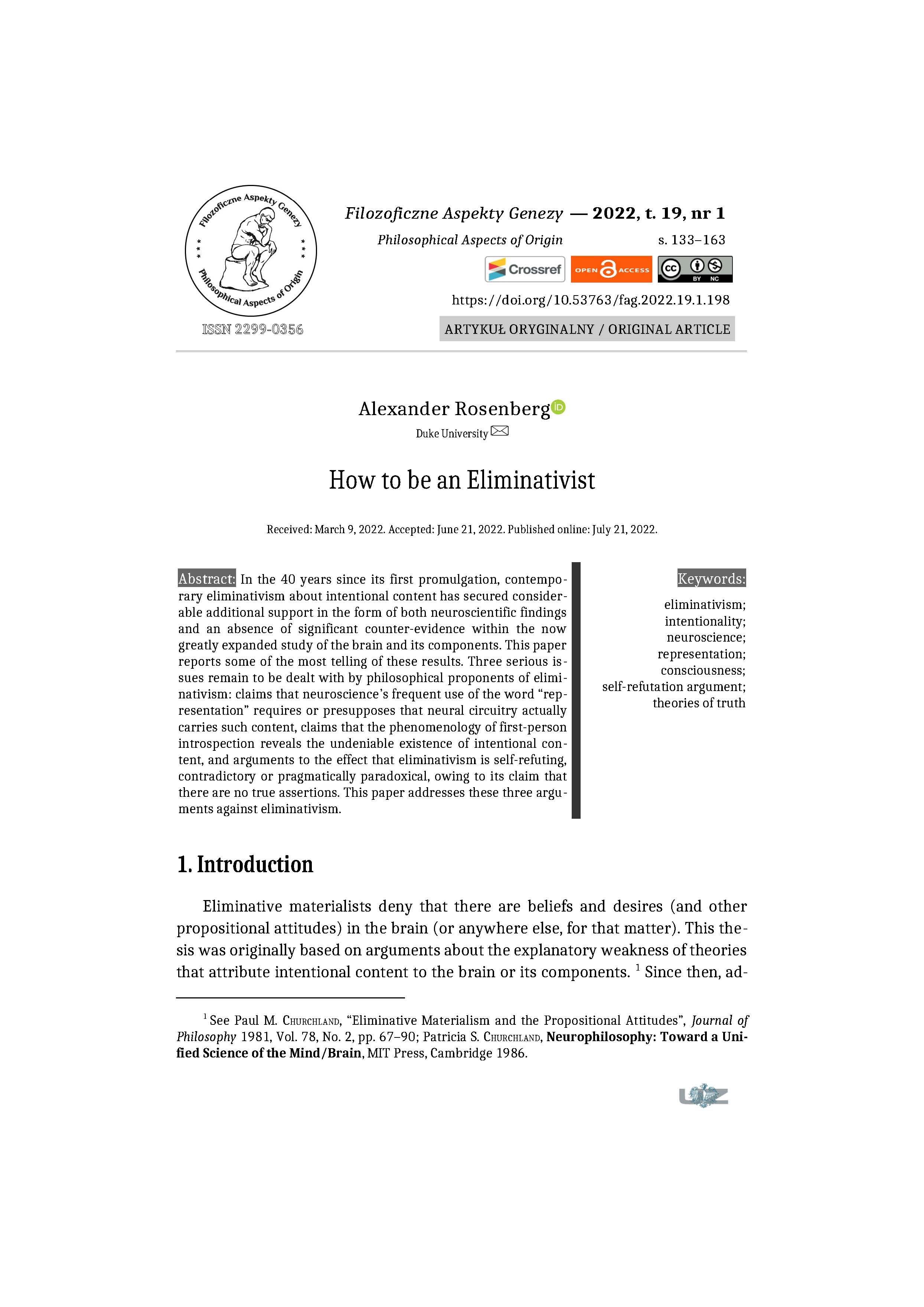
Opublikowane 21.07.2022 — zaktualizowane 18.08.2022
Wersje
- 18.08.2022 - (2)
- 21.07.2022 - (1)
Słowa kluczowe
- eliminativism,
- intentionality,
- neuroscience,
- representation,
- consciousness
- self-refutation argument,
- theories of truth ...More
Prawa autorskie (c) 2022 Filozoficzne Aspekty Genezy

Utwór dostępny jest na licencji Creative Commons Uznanie autorstwa – Użycie niekomercyjne 4.0 Międzynarodowe.
Jak cytować
Abstrakt
In the 40 years since its first promulgation, contemporary eliminativism about intentional content has secured considerable additional support in the form of both neuroscientific findings and an absence of significant counter-evidence within the now greatly expanded study of the brain and its components. This paper reports some of the most telling of these results. Three serious issues remain to be dealt with by philosophical proponents of eliminativism: claims that neuroscience’s frequent use of the word “representation” requires or presupposes that neural circuitry actually carries such content, claims that the phenomenology of first-person introspection reveals the undeniable existence of intentional content, and arguments to the effect that eliminativism is self-refuting, contradictory or pragmatically paradoxical, owing to its claim that there are no true assertions. This paper addresses these three arguments against eliminativism.
Downloads
Bibliografia
- Azizi Amir H., Wiskott Laurenz, and Cheng Sen, A Computational Model for Preplay in the Hippocampus, Frontiers of Computational Neuroscience 2013, Vol. 7, article number: 161, https://doi.org/10.3389/fncom.2013.00161.
- Bayne Tim and Montague Michelle (eds.), Cognitive Phenomenology, Oxford University Press, Oxford 2011.
- Berg Nathan and Gigerenzer Gerd, As-If Behavioral Economics: Neoclassical Economics in Disguise?, History of Economic Ideas 2010, Vol. 18, No. 1, pp. 133–165.
- Boghossian Paul A., The Status of Content, Philosophical Review 1990, Vol. 99, No. 2, pp. 157–184.
- Carruthers Peter and Smith Peter K. (eds.), Theories of Theories of Mind, Cambridge University Press, Cambridge 1996.
- Chalmers David J. (ed.), Philosophy of Mind: Classical and Contemporary Readings, Oxford University Press, Oxford 2002.
- Churchland Patricia S., Neurophilosophy: Toward a Unified Science of the Mind/Brain, MIT Press, Cambridge 1986.
- Churchland Paul M., Eliminative Materialism and the Propositional Attitudes, Journal of Philosophy 1981, Vol. 78, No. 2, pp. 67–90.
- Dawkins Richard, The Extended Phenotype: The Long Reach of the Gene, Oxford University Press, Oxford 1982.
- Dragoi George, Internal Operations in the Hippocampus: Single Cell and Ensemble Temporal Coding, Frontiers in Systems Neuroscience 2013, Vol. 7, article number: 46, https://doi.org/10.3389/fnsys.2013.00046.
- Dretske Fred, Naturalizing the Mind, Bradford Books, MIT Press, Cambridge 1995.
- Godfrey-Smith Peter, Review of Brian Skyrms’ Signals, Mind 2012, Vol. 120, No. 480, pp. 1288–1297.
- Grice Paul, Meaning, in: Grice, Studies in the Way of Words…, pp. 213–223.
- Grice Paul, Studies in the Way of Words, Harvard University Press, Cambridge 1989.
- Horgan Terence E. and Tienson John L., The Intentionality of Phenomenology and the Phenomenology of Intentionality, in: Chalmers (ed.), Philosophy of Mind…, pp. 520–533.
- Huys Quentin J.M., Eshel Neir, O’Nions Elizabeth, Sheridan Luke, Dayan Peter, and Roiser Jonathan P., Bonsai Trees in Your Head: How the Pavlovian System Sculpts Goal-Directed Choices by Pruning Decision Trees, PL0S Computational Biology 2015, Vol. 8, No. 3, e1002410.
- Jacquette Dale, Sensation and Intentionality, Philosophical Studies 1985, Vol. 47, No. 3, pp. 429–440.
- Joffe Michael, Mechanism in Behavioral Economics, Journal of Economic Methodology 2019, Vol. 26, No. 3, pp. 228–242.
- Kandel Eric R., The Molecular Biology of Memory Storage: A Dialog between Genes and Synapses, Nobel Lecture 2000, December 8, https://tiny.pl/93nvv [02.03.2022].
- Kruschke John K., ALCOVE: An Exemplar Based Connectionist Model of Category Learning, Psychological Review 1992, Vol. 99, No. 1, pp. 22–44.
- Kubie John L. and Fox Steven E., Do the Spatial Frequencies of Grid Cells Mold the Firing Fields of Place Cells?, Proceedings of the National Academy of Sciences USA 2015, Vol. 112, No. 13, pp. 3860–3861, https://doi.org/10.1073/pnas.1503155112.
- Lewis David, Convention, Harvard University Press, Cambridge 1969.
- Lewis David, New Work for a Theory of Universals, Australasian Journal of Philosophy 1983, Vol. 61, No. 4, pp. 343–377.
- Mante Valerio, Sussillo David, Shenoy Krishna V., and Newsome William T., Context-Dependent Computation by Recurrent Dynamics in Prefrontal Cortex, Nature 2013, Vol. 503, pp. 78–84.
- Moser Edvard I., Grid Cells and the Entorhinal Map of Space, Nobel Lecture 2014, December 7, https://tiny.pl/93n6b [02.03.2022].
- Moser Edvard I., Roudi Yasser, Witter Menno P., Kentros Clifford, Bonhoeffer Tobias, and Moser May-Britt, Grid Cells and Cortical Representation, Nature Reviews Neuroscience 2014, Vol. 15, pp. 466–481.
- Moser May-Britt, Grid Cells, Place Cells, and Memory, Nobel Lecture 2014, December 7, https://tiny.pl/93nvq [02.03.2022].
- Nichols Shaun, Stich Stephen, Leslie Alan, and Klein David, Varieties of Off-Line Stimulation, in: Carruthers and Smith (eds.), Theories of Theories of Mind…, pp. 39–74.
- O’Keefe John, Spatial Cells in the Hippocampal Formation, Nobel Lecture 2014, December 7, https://tiny.pl/93nvm [02.03.2022].
- O’Keefe John and Dostrovsky Jonathan, The Hippocampus as a Spatial Map: Preliminary Evidence from Unit Activity in the Freely-Moving Rat, Brain Research 1971, Vol. 34, No. 1, pp. 171–175.
- Paul L.A., Categorical Priority and Categorical Collapse, Proceedings of the Aristotelian Society 2013, Vol. 87, Supplementary Volumes, pp. 89–113.
- Purves Dale and Lotto R. Beau, Why We See What we Do Redux: A Wholly Empirical Theory of Vision, Sinauer Associates, Sunderland 2011.
- Quine Willard Van Orman, Word and Object, MIT Press, Cambridge 1961.
- Rosenberg Alexander, Naturalistic Epistemology for Eliminative Materialists, Philosophy and Phenomenological Research 1999, Vol. 59, No. 2, pp. 335–358.
- Rushworth Matthew F.S., Noonan Maryann P., Boorman Erie D., Walton Mark E., and Behrens Timothy E., Frontal Cortex and Reward Guided Learning and Decision Making, Neuron 2009, Vol. 70, No. 6, pp. 1054–1069.
- Searle John R., Intentionality: An Essay in the Philosophy of Mind, Cambridge University Press, Cambridge 1983.
- Searle John R., Minds, Brains and Programs, The Behavioral and Brain Sciences 1980, Vol. 3, No. 3, pp. 417–424.
- Shea Nicholas, Representation in Cognitive Science, Oxford University Press, Oxford 2018.
- Skyrms Brian, Signals: Evolution, Learning and Information, Oxford University Press, New York 2010.
- Stich Stephen, Do True Believers Exist? A Reply to Andy Clark, Aristotelian Society Supplement 1991, Vol. 65, pp. 229–244.
- Stich Stephen, From Folk Psychology to Cognitive Science, MIT Press, Cambridge 1983.
- Strawson Galen, Cognitive Phenomenology: Real Life, in: Bayne and Montague (eds.), Cognitive Phenomenology…, pp. 285–325.
- Szabό Gendler Tamar and Hawthorne John (eds.), Perceptual Experience, Oxford University Press, Oxford 2006.
- Unger Peter, There Are No Ordinary Things, Synthese 1979, Vol. 41, No. 2, pp. 117–154.
- Van Essen David C. and Gallant Jack L., Neural Mechanisms of Form and Motion Processing in the Primate Visual System, Neuron 1994, Vol. 13, No. 1, pp. 1–10.
- Van Inwagen Peter, Material Beings, Cornell University Press, Ithaca 1990.
- Yu Jai Y. and Frank Loren M., Hippocampal-Cortical Interaction in Decision Making, Neurobiology of Learning and Memory 2015, Vol. 117, pp. 34–41, https://tiny.pl/93nbq [02.03.2022].
- Yu Jai Y., Kay Kenneth, Liu Daniel F., Grossrubatscher Irene, Loback Adrianna, Sosa Marielena, Chung Jason E., Karlsson Mattias P., Larkin Margaret C., and Frank Loren M., Distinct Hippocampal-Cortical Memory Representations for Experiences Associated with Movement versus Immobility, eLife 2017, Vol. 6, e27621, https://doi.org/10.7554/eLife.27621.


